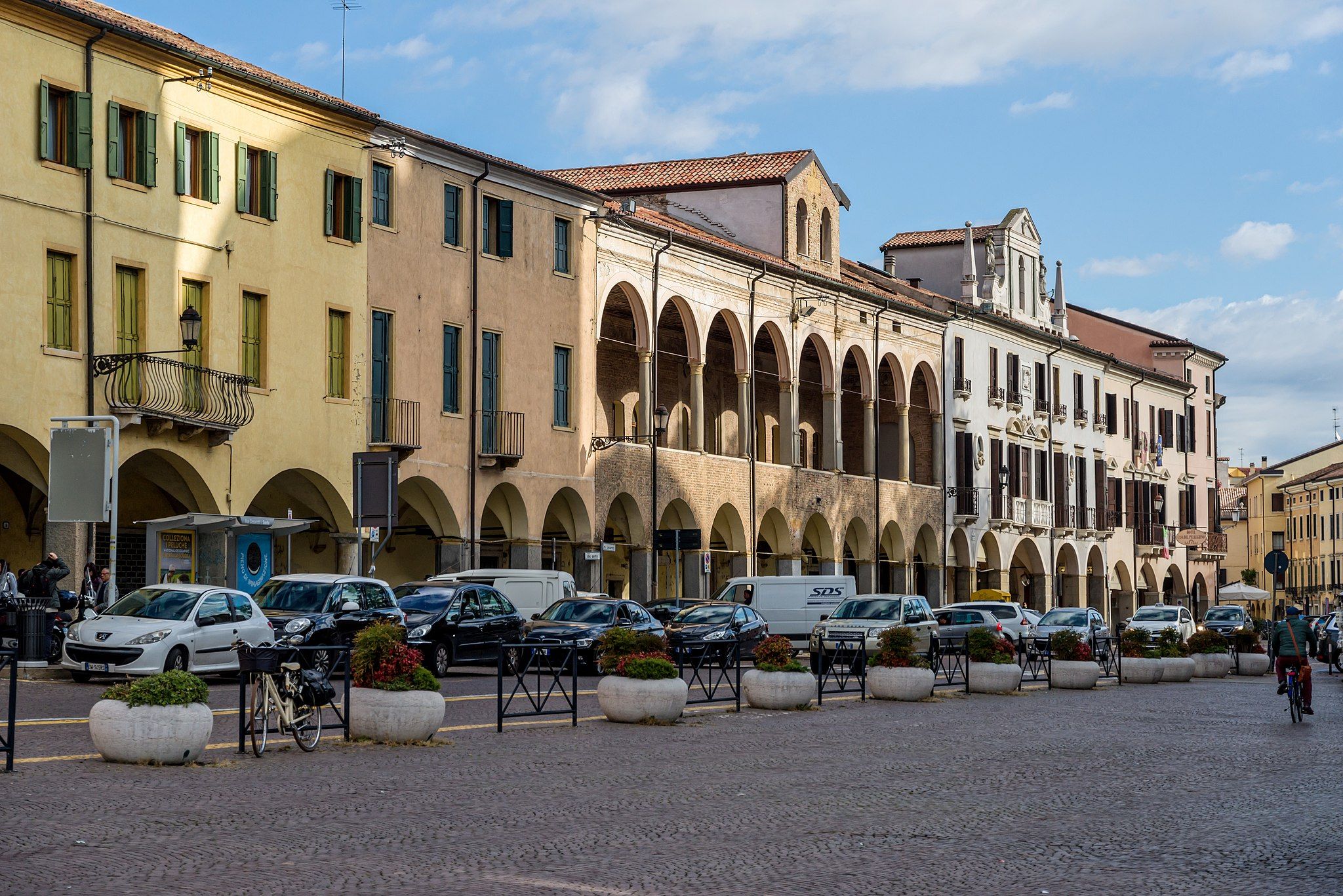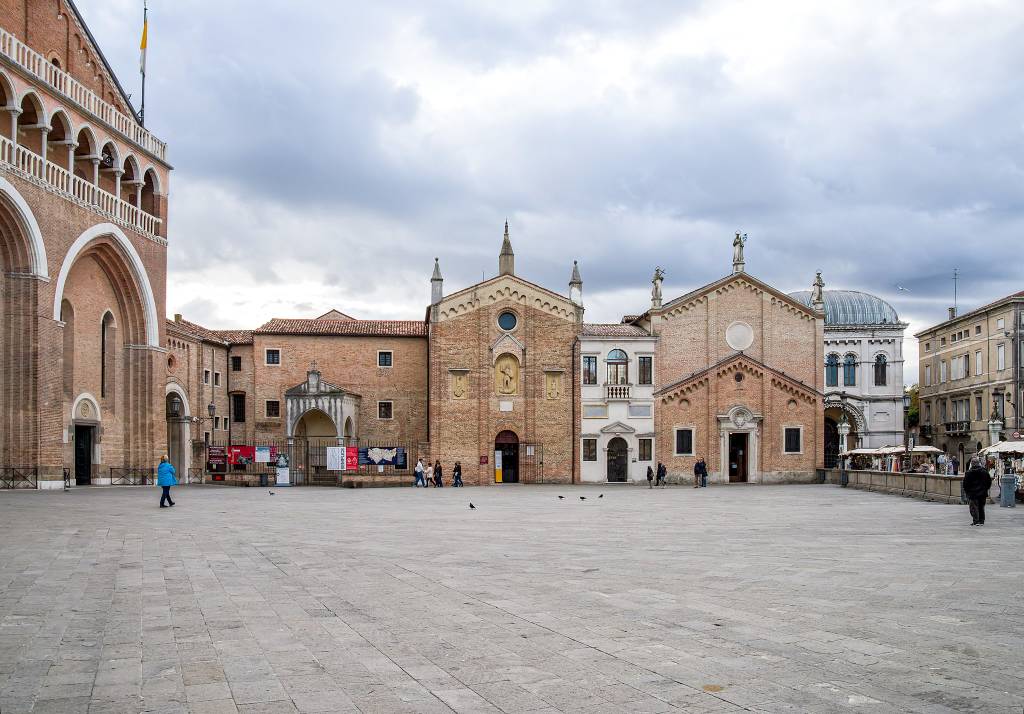Piazza del Santo
Piazza del Santo is a miniature citadel sheltered by the splendid masterpieces of the Oratory of Saint George and the Gattamelata statue.

Piazza del Santo is dominated by the imposing silhouette of the Basilica of Saint Anthony, built between 1232 and the mid-1300s to house the tomb of Saint Anthony of Padua. Next to the Basilica del Santo is the Oratory of Saint George, the School of the Saint and the Musem of the Saint.
The square is located a few hundred meters from the large open square Prato della Valle, to which it is connected through the charming street Via Beato Luca Belludi.
In front of the Basilica of the Saint is the equestrian monument of Gattamelata, a masterpiece sculpted in bronze by Donatello between 1446 and 1453.
The Gattamelata Monument
The statue, a medieval version of the equestrian effigy of Marcus Aurelius in Rome, was erected in honour of the leader of the Venetian Republic, Erasmo of Narni. Better known by his nickname of Gattamelata, he was famous for his military exploits, among which he defended the Serenissima against the attacks by the Duchy of Milan and conquered the city of Verona.
After his death, his widow Giacoma della Leonessa commissioned Donatello for the famous statue. Donatello used emotion, position, and symbolism to portray Gattamelata as a man of power. He is shown leading his troops, bare-headed and dressed in robust armour. The gaze is severe and the sight fixes a distant point. His left hand holds the baton of command. The left hoof rests on a cannonball, an expedient that allows the statue to maintain a better balance while giving the illusion of trot.
The statue is one of the greatest masterpieces of the Renaissance and is commonly considered the finest equestrian statue of all time. It was made with the lost wax technique, an ancient technique used by Donatello and was presumably the first large cast equestrian statue since ancient times. On the sides of the trachyte pedestal there are two doors: the doors of life, closed, and the door of death left ajar.
Scoletta del Santo
The School of the Saint is the seat of the Confraternity of Saint Anthony of Padua. The building was erected in 1427 and has a simple brick facade, typical of Antonian churches.
In 1504 it was raised by the creation of the Sala Priorale (Priory Hall). The room has a coffered ceiling sculpted by Giovanni Cavalieri and painted by Domenico Bottazzo. It is adorned with frescoes that narrate the life and works of the Saint. Among these stand out the paintings by Bartolomeo Montagna, Girolamo del Santo and three early works by Tiziano Vecellio made between 1510 and 1511: the Miracle of the newborn, the Miracle of the healed foot and the Miracle of the jealous husband.
In 1736 the small building that connects the School to the Oratory of Saint George was erected, with the large monumental staircase leading to the Sala Priorale.
Oratorio di San Giorgio
The Oratory of Saint George is an elegant building in Romanesque style, with a facade made of exposed brick and three stone bas-reliefs, among which Saint George killing the dragon stands out in the centre.
The Oratory was built in 1377 as a family mausoleum by the Marquis Raimondino Lupi di Soragna, a leader in the service of the Carraresi, inspired by the frescoes made by Giotto in the Scrovegni Chapel. The sarcophagus of the Marquis Raimondino was placed along the right wall.
The frescoes were made by Altichiero da Zevio between 1379 and 1384 and are now part of the UNESCO World Heritage propriety Padua Urbs Picta. The interior has a barrel vault painted with a starry sky, where busts of saints are inserted, symbols of the Evangelists, Prophets and Doctors of the Church. The side walls are divided into two overlapping bands: on the left, there are scenes from the Life of Saint George, on the right scenes from the Martyrdom of Saint Catherine of Alexandria and Saint Lucia. The back wall is dominated by a large Crucifixion, surmounted by a Coronation of Mary among the angelic choirs, while the counter-façade presents scenes from the Childhood of Christ.
Al Santo Museum
The Al Santo Museum was built between 1870 and 1880 to house the artistic heritage of the Civic Museum. Camillo Boito designed the facade in white Botticino marble and the grand access staircase.
After the transfer of the Civic Museum to the current headquarters at the Eremitani, the Al Santo Museum was for a long time used for setting up temporary exhibitions.
We welcome all contributions, no matter how small. Even a spelling correction is greatly appreciated.
All submissions are reviewed before being published.
Continue to changelog-

© 'Piazza del Santo' by joergens.mi is licensed under CC BY-SA 4.0 Attribution copied to clipboard Failed copying attribution to clipboard -

© 'Piazza del Santo' by joergens.mi is licensed under CC BY-SA 4.0 Attribution copied to clipboard Failed copying attribution to clipboard -

© 'Piazza del Santo' by joergens.mi is licensed under CC BY-SA 4.0 Attribution copied to clipboard Failed copying attribution to clipboard -

We welcome all contributions.
All submissions are reviewed before being published.
We welcome all contributions, no matter how small. Even a spelling correction is greatly appreciated.
All submissions are reviewed before being published.
Continue to changelogWe welcome all contributions, no matter how small. Even a spelling correction is greatly appreciated.
All submissions are reviewed before being published.
Continue to changelogWe welcome all contributions, no matter how small. Even a spelling correction is greatly appreciated.
All submissions are reviewed before being published.
Continue to changelogCategory
Cost
-
One of the most famous and visited sanctuaries in the world and a testament of art decorated by Giotto, Giusto de' Menabuoi, Altichiero da Zevio, and Jacopo Avanzi
-
Once the humble dwelling of Saint Anthony, the Friary developed over the centuries into the five splendid cloisters located on the southern side of the Basilica.
-
An aristocratic family mausoleum decorated by Altichiero da Zevio with frescoes depicting scenes from the Life of Christ and of Saint George
-
The oldest Heritage Garden in the world, home to over 6,000 different plant specimens and the futuristic Garden of Biodiversity
-
The Giardino Treves de' Bonfili is one of Padua’s most renowned historical gardens, a hidden jewel of architectural and landscape creation by Giuseppe Jappelli.




